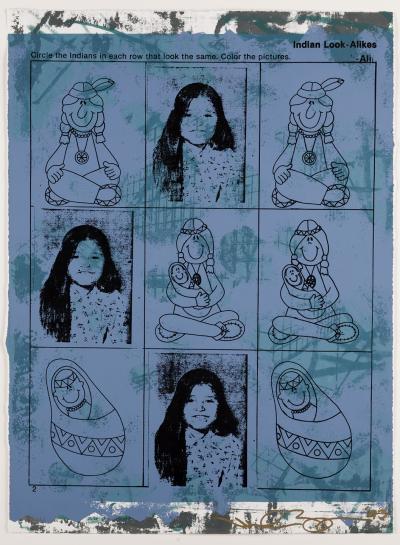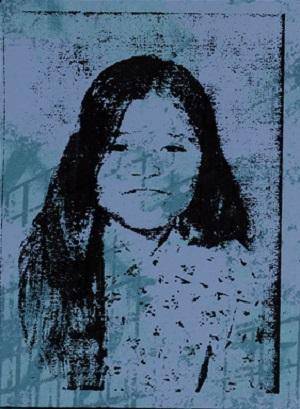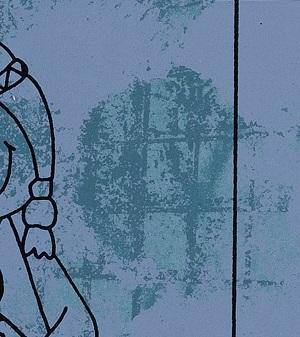Students will examine the message and artistic choices behind Indian Look-Alike. They will then create their own work of art inspired by Melanie Yazzie’s work.
Students will be able to:
- explain why Melanie Yazzie made Indian Look-Alike;
- discuss the power of visual imagery to communicate important messages;
- identify different stereotypes and discuss their impact; and
- feel comfortable taking creative risks to make a work of art.
Lesson
- Preparation: Prepare art supplies and have them ready to hand out quickly so there is enough time to complete the project. If students do not have enough time to finish, the art project can extend into another day
- Warm-up: Ask students to write down what they think the following phrase means: “A picture is worth a thousand words.” Tell them they can even draw a picture to show their answer if they’d like. Call on students to share their ideas or images.
- Arrange students into groups of 3–4. Ask them to examine Indian Look-Alike and the About the Art Section and discuss how the artist’s use of her childhood photograph, text from the worksheet, and stereotypical imagery combine to tell an important story and deliver an important lesson. What is her message? Make sure to help students maintain a positive atmosphere without joking or making fun of others. This topic is very sensitive and can be hurtful if not managed carefully.
- Call on groups to share some of their main ideas with the entire class. Write down these ideas.
- Lead a discussion on how delivering the message via imagery versus words changes the message. Is it more powerful? How? Why? Help students analyze elements of the piece that help the artist deliver a more powerful message (e.g., the juxtaposition of her personal photograph with the cartoon images; the use of color). Why do her choices strengthen the message? Ask students if they can think of any ads or works of art they have seen recently that use visual imagery to communicate meaning.
- Watch the video of Melanie Yazzie talking about Indian Look-Alike, focusing on both stereotyping and the reasons behind the visual choices she made.
- Have students brainstorm with a partner on different stereotypes they encounter, either as teenagers or in relation to their race, religion, socioeconomic status or other aspect of their identity. Ask for volunteers to share their ideas with the entire class.
- Pass out the 11×14-inch pieces of cardboard. Tell the students that they are going to create their own piece about stereotypes in their lives. They should think about how the images and colors they choose will influence the impact of their piece.
- Students will then create their own piece, using images from the Internet, photographs, and/or sketches to battle against a stereotype of their choosing. Students can combine collage, marker, watercolor, and ink to create the effect they’re after.
- Have students share their pieces in groups of 3–4. They should try to figure out the stereotype represented in each piece before the student who created it talks about his or her work.
Materials
- Paper and pencil or pen for each student
- Computers and Internet access for students to conduct research
- Magazines, photographs, and the ability to print images from the Internet
- One 11×14-inch piece of cardboard for each student
- Scissors
- Glue sticks
- Watercolors, water cups, brushes, and paper towels
- Newspaper to cover desks/tables
- Copies of the About the Art section on Indian Look-Alike (included with the lesson plan) or student access to this part of Creativity Resource online
- Color copies of Indian Look-Alike for students to share, or the ability to project the image onto a wall or screen
- Ability to play the video of the artist talking about her work for the whole class to watch
- NOTE: If conducting this lesson with an art class, please feel free to modify the lesson to use a wider variety of media
Standards
- Social Studies
- History
- Evaluate and analyze sources using historical method of inquiry and defend their conclusions
- Become familiar with Western Hemisphere historical eras, groups, individuals and themes
- Analyze the concept of complexity, unity and diversity
- Visual Arts
- Invent and Discover to Create
- Observe and Learn to Comprehend
- Relate and Connect to Transfer
- Envision and Critique to Reflect
- Language Arts
- Oral Expression and Listening
- Collaboration
- Critical Thinking & Reasoning
- Information Literacy
- Invention
- Self-Direction

Indian Look-Alike
Melanie Yazzie, Navajo/Diné, United States
1993
Height: 29 in. Width: 22.5 in.
Gift of Melanie Yazzie and Clark Barker, 2007.4155
Photograph © Denver Art Museum 2012. All Rights Reserved.
Born in 1966, Melanie Yazzie grew up on the Navajo reservation in northern Arizona. She earned her Bachelor of Arts degree at Arizona State University and a Master of Fine Arts degree in printmaking at the University of Colorado, Boulder, where she is now an associate professor of art. Yazzie works in a variety of media including printmaking, painting, sculpture, installation art, and ceramics, and has led several collaborative international projects with artists in New Zealand, Siberia, Australia, Canada, Mexico, Germany, and Japan.
Yazzie’s artwork explores themes of childhood memories, travel and transformation, the role of women in Navajo culture, post-colonial dilemmas, and her personal health. “The work I make is about my personal experience as a Navajo woman in today’s society,” she says.
The overall concept of this piece was inspired by Yazzie’s work with the community and her efforts to educate students about Native American stereotypes. She was shocked when she went to speak to a school class and saw that the children were given a worksheet with stereotypical images of Indians under the same prompt that appears at the top of her print:
Circle the Indians in each row that look the same. Color the pictures.
“I looked at [the worksheet] and thought I do not look like these [nor does] anyone I have ever known. I decided to take the art project and make one of my own, inserting my own childhood image,” Yazzie explains.
Details

The Title and Prompt
The title of the print and the instructions at the top are exactly the same as those on the worksheet that was given to the elementary school children.

Childhood Image
The image of Yazzie as a girl doesn’t resemble the cartoonish Indians at all. By inserting her image into each row, Yazzie makes it obvious which “Indians” look the same and makes the point that Native Americans are individuals, not types.

Background Color and Pattern
According to Yazzie, the background color and pattern resemble a turquoise stone. Turquoise plays a large role in Navajo religious ceremonies and is prominent in Navajo jewelry. It is thought to promote healing and good luck.
Funding for object education resources provided by a grant from the Morgridge Family Foundation. Additional funding provided by the William Randolph Hearst Endowment for Education Programs, and Xcel Energy Foundation. We thank our colleagues at the University of Denver Morgridge College of Education.
The images on this page are intended for classroom use only and may not be reproduced for other reasons without the permission of the Denver Art Museum. This object may not currently be on display at the museum.







